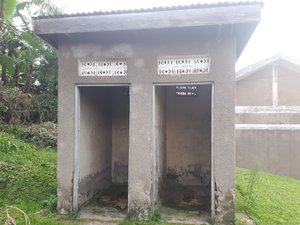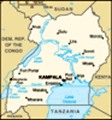Advertisement
Published: July 17th 2019

 Our pit latrines
Our pit latrines
It happened to be located on top of a small hill a little ways away from our dorms. When someone saw you walk in this direction, they knew you were heading for a short call (Ugandan lingo for bathroom break).It’s me again!
I am not on the road to Kampala, but I still need to catch up on my blogging. My last post finished when I returned to Rugazi to begin our community placement (the real deal this time). Divided into the groups Rugazi A and B, twenty of us packed into a MUST bus and sped down the speed-bump-riddled roads to the Rubirizi district (we call our roadtrips African massages since you get shaken up pretty well).
Upon arrival, we realised had no running water again. No big deal, because it will come back on right away right? Not so this time, and our custodian/babysitter (because we’re clueless as babies) Martin recruited the guys haul 20L jerry cans for our water needs. This is when I learnt the interesting way that Ugandans close their jerry cans: they shove a small green banana into the spout! Now that’s a biodegradable alternative to plastic caps.
Given our lack of water, we also needed an alternative to flushable toilets. That week marked the first time that I used a pit latrine, and while the picture isn’t pretty, I can say that the experience isn’t nearly as bad as I

 Our banana caps
Our banana caps
Plastic caps are out of style. Go green with bananas.imagined. Yes, there’s no doors in certain stalls, but our running joke is that you wouldn’t want to be in there alone anyways. What if you fell down the pit? However, you might not be alone in any case because the flies will keep you company.
Our first day in Rugazi involved attending the english service of a neighbouring church. The service turned out to be almost entirely in runyankole, but the singing and dancing of the children’s choir was beautiful to the ears. As in most churches, us visitors are easily noticed despite our efforts to stay discrete at the back of the church. We were sitting in a wing adjacent to the pulpit, and we had no idea how crowded was the main sanctuary because we couldn’t see it. Imagine my surprise when the priest called us up to the front to introduce ourselves (because we stuck out like sore thumbs), and a sea of faces suddenly came into our view. It was so impressive because it didn’t seem like there was even one empty seat. After us, a health official from the government came to the front and talked about the threat of Ebola in Uganda

 Latrine squad
Latrine squad
We didn't want to go to the latrines alone... Three's a crowd but it's also a party.and prevention methods to stay safe. It was really awesome to see health education efforts in action and how receptive the congregation was to them. Ugandans are definitely not messing around with Ebola.
A few days later, I had the opportunity to go to the biweekly Rugazi market with Brooke, and the Ugandan students Veronica and John. We were tasked with buying an assortment of groceries for the group while following a tight budget, but early in our shopping spree, we faced a significant obstacle to our goal: mzungu pricing. Simply put, everything, whether it be green peppers, a scarf, or a boda ride, is more expensive for foreigners compared to locals. This is true of most places in the world, and most travellers will be able to relate to it. As John and I walked away from a fish counter where the woman would not budge from her 10 000 shillings price for one smoked fish (approximately $3.5 CAN), John laughed while saying he would never get a fair price (which was 5000 according to him) if I came with him to the vendors' stands. Being used to such a high price of living back home, I honestly wouldn’t have batted an eye at paying the first price given to me. But here, whether or not you break the bank while travelling depends on your bartering skills.
So how do you avoid mzungu pricing? Here are the bartering tips I picked up since the beginning of my time in Uganda.
1.Have a Ugandan friend with you. They know the normal pricing, and while you'll be busy trying to convert the price into Canadian dollars in your head, they will have already told you if you are getting ripped off.
2.Know your shop. Don't start bartering in a shop where the items have price tags. That's usually a good indication that the prices are fixed, and any attempts at lowering them will draw some funny looks from the shopkeeper.
3.Aim to pay half the starting price. That means you have to start lower than half to allow wiggle room for negotiating. If a scarf is sold at 40 000 ($14 CAN), start at 10 000 to hopefully end up around 20 000.
4.When insisting on your price, have your money in your hand. I've never tried doing this, but Victoria swears it works since it shows that you are ready to pay immediately and that you have no other money to use for this particular purchase.
5.Know when to walk away. If the price isn't coming down, don't feel pressured to buy whatever you're bartering for. Once you walk away, some vendors will run after you and let the price, and if not, you are almost guaranteed to find a similar product in another stand for a different price.
6.Finally, keep things in perspective. Realize you're probably going to be terrible at bartering for the first little while. You'll pay two or three times the normal price for mangos, or the “original” painting you'll have gotten a “great deal” on will be a copy that you see in a roadside market in another town. It’s a bummer, but once you convert your day’s total into Canadian dollars, you'll realize that you're probably spending much less than you thought. And either way, you’re supporting the local economy, and you're getting the tastiest mangos you've ever had.
After the market, Brooke and I had the opportunity to accompany Paul, the HIV counsellor from the health center, on his outreach day. He brings HIV testing kits to high-risk areas to test people who wouldn't otherwise seek to get tested. Unfortunately, we lost track of time at the market (Veronica, being our African mama, made us sit down and refresh ourselves with a freshly sliced wedge of watermelon since it was a scorching day) and ended up being late to the outreach. Paul teased us by saying that we were running on African time now. That's not a habit I should take back to Canada… but back to the outreach. It was very cool to see Paul interact with community members and provide education, and for those diagnosed, begin counselling right then and there. He taught us that many bars and hotel workers, most of them young women, also do sex work for supplemental income and that they are the group that is most at-risk for HIV. In the Rubirizi district where Rugazi is located, women are disproportionately affected by HIV- approximately 7% of the entire female population as compared to around 4% of men according to the health center’s ART clinic statistics. The clinic also registers an average of ten new cases of HIV per week, making the Rubirizi district one of the region's of Uganda with the highest rates of HIV.
Hearing about the prevalence of HIV in Rugazi made me glad that antiretroviral treatment is covered by the federal government and is available to everyone who requires it in Uganda. The accessibility of this treatment should decrease the spread of HIV right? Paul has a different perspective since he believes that people have lost their fear of HIV now that ART medication is so readily available. It’s now a condition you can live with as long as you keep up with the treatment that happens to be free in any health center. According to Paul, people generally believe it is better to get infected with HIV during as risky sexual encounter rather than get pregnant. They then don't take the measures to protect themselves or others. However, he noted, while the fear of HIV is gone, the stigma isn't, and people would go to great lengths to keep their neighbours from finding out about their HIV status. How do we remedy this situation? Free treatment always sounds like the best course of action, especially to Canadians raised in a socialized healthcare system, but it has had surprising and unfortunate repercussions. It definitely gave me food for thought.
I believe this is my longest blog post yet! I will sign off, and save some stories for my next post. Until next time!
Advertisement
Tot: 0.086s; Tpl: 0.011s; cc: 7; qc: 55; dbt: 0.0471s; 1; m:domysql w:travelblog (10.17.0.13); sld: 1;
; mem: 1.2mb







